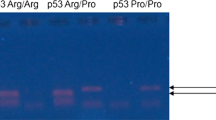Abstract
Purpose
It was shown that individuals homozygous for the Arg-encoding allele of codon 72 TP53 gene may have an increased risk to human papillomavirus (HPV)-related cervical carcinomas. However, many studies have failed to confirm this hypothesis. The aim of this study was to investigate a role of the TP53 codon 72 polymorphism in cervical carcinoma development in Serbian women.
Methods
In comparative, prospective study, we analyzed 49 wild type TP53 gene cervical carcinomas samples and 74 cervical smears of gynecologically healthy women. DNA was extracted by salting-out procedure. Codon 72 polymorphism was assessed by Restriction Fragment-Length Polymorphism method. Presence of HPV infection was detected through amplification of one part of L1 viral gene. χ2 and odds ratio were used for statistical analysis.
Results
The distribution of Arg/Arg, Arg/Pro, and Pro/Pro genotypes of codon 72 of TP53 gene was: 63.3, 34.7, and 2.0 % in the cervical carcinomas and 58.1, 33.8, and 8.1 % in the control group. We observed an increased risk for the development of cervical carcinoma for Arg homozygotes in relation to heterozygotes plus Pro homozygotes (OR 1.24; 95 % CI 0.59–2.61) and higher one for Arg/Arg plus Arg/Pro genotype in relation to Pro homozygotes (OR 4.24; 95 % CI 0.49–36.32).
Conclusions
The results indicate that carriers of Arg allele of codon 72 TP53 gene have an increased risk for development of cervical carcinoma in Serbian women. However, the influence is not statistically significant and requires analysis of larger case–control group.


Similar content being viewed by others
References
Jemal A, Bray F, Center MM, Ferlay J, Ward E, Forman D (2011) Global cancer statistics. CA Cancer J Clin 61:69–90
Kesić V, Jovićević-Bekić A, Vujnović M (2007) Cervical cancer screening in Serbia. Coll Antropol 31:31–36
Tjiong MY, Out TA, Ter Schegget J, Burger MP, Van Der Vange N (2001) Epidemiologic and mucosal immunologic aspects of HPV infection and HPV-related cervical neoplasia in the lower female genital tract: a review. Int J Gynecol Cancer 11:9–17
von Knebel Doeberitz M (2002) New markers for cervical dysplasia to visualise the genomic chaos created by aberrant oncogenic papillomavirus infection. Eur J Cancer 38:2229–2242
Burd ME (2003) Human papillomavirus and cervical Cancer. Clin Microbiol Rev 16:1–17
Andersson S, Rylander E, Larsson B, Strand A, Silfversvärd C, Wilander E (2001) The role of human papillomavirus in cervical adenocarcinoma carcinogenesis. Eur J Cancer 37:246–250
Nagpal JK, Sahni S, Das BR (2002) P53 codon 72 polymorphism and susceptibility to development of human papilloma virus-associated cervical cancer in Indian women. Eur J Clin Invest 32:943–948
Castellsaqué X, Bosh FX, Muñoz N (2002) Environmental co-factors in HPV carcinogenesis. Virus Res 89:191–199
Thomas M, Kalita A, Labrecque S, Pim D, Banks L, Matlashewski G (1999) Two polymorphic variants of wild-type p53 differ biochemically and biologically. Mol Cell Biol 19:1092–1100
Pim D, Banks L (2004) p53 polymorphic variants at codon 72 exert different effects on cell cycle progression. Int J Cancer 108:196–199
Marin MC, Jost CA, Brooks LA et al (2000) A common polymorphism acts as an intragenic modifier of mutant p53 behaviour. Nat Genet 25:47–54
Storey A, Thomas M, Kalita A et al (1998) Role of a p53 polymorphism in the development of human papillomavirus-associated cancer. Nature 393:229–234
Zar JH (1999) Biostatistical analysis, 4th edn. Prentice-Hall, Inc., Englewood Cliffs
de Roda Husman AM, Walboomers JM, van den Brule AJ, Meijer CJ, Snijders PJ (1995) The use of general primers GP5 and GP6 elongated at their 3′ ends with adjacent highly conserved sequences improves human papillomavirus detection by PCR. J Gen Virol 76:1057–1062
Malisic E, Jakovljevic K, Jankovic R, Radulovic S (2011) TP53 gene status and HPV infection in response to platinum-plus taxane-based chemotherapy of ovarian carcinomas. J BUON 16:701–707
Jee SH, Won SY, Yun JE, Lee JE, Park JS, Ji SS (2004) Polymorphism p53 codon-72 and invasive cervical cancer: a meta-analysis. Int J Gynaecol Obstet 85:301–308
Sousa H, Santos AM, Pinto D, Medeiros R (2007) Is the p53 codon 72 polymorphism a key biomarker for cervical cancer development? A meta-analysis review within European populations. Int J Mol Med 20:731–741
Klug SJ, Ressing M, Koenig J et al (2009) TP53 codon 72 polymorphism and cervical cancer: a pooled analysis of individual data from 49 studies. Lancet Oncol 10:772–784
Koushik A, Platt RW, Franco EL (2004) p53 codon 72 polymorphism and cervical neoplasia: a meta-analysis review. Cancer Epidemiol Biomark Prev 13:11–22
Whibley C, Pharoah PD, Hollstein M (2009) p53 polymorphisms: cancer implications. Nat Rev Cancer 9:95–107
Ferenczy A, Franco E (2002) Persistent human papillomavirus infection and cervical neoplasia. Lancet Oncol 3:11–16
Pietsch EC, Humbey O, Murphy ME (2006) Polymorphisms in the p53 pathway. Oncogene 25:1602–1611
Clifford GM, Gallus S, Herrero R et al (2005) Worldwide distribution of human papillomavirus types in cytologically normal women in the International Agency for Research on Cancer HPV prevalence surveys: a pooled analysis. Lancet 366:991–998
de Sanjosé S, Diaz M, Castellsagué X, Clifford G, Bruni L, Muñoz N, Bosch FX (2007) Worldwide prevalence and genotype distribution of cervical human papillomavirus DNA in women with normal cytology: a meta-analysis. Lancet Infect Dis 7:453–459
Tábora N, Bakkers JM, Quint WG, Massuger LF, Matute JA, Melchers WJ, Ferrera A (2009) Human papillomavirus infection in Honduran women with normal cytology. Cancer Causes Control 20:1663–1670
De Vuyst H, Parisi MR, Karani A et al (2010) The prevalence of human papillomavirus infection in Mombasa, Kenya. Cancer Causes Control 21:2309–2313
Acknowledgments
The authors truly thank Gordana Kukic and Filip Stojanovic for their excellent technical assistance. This study was financially supported by the No. 41026 grant of the Ministry of Education and Science of Serbia.
Conflict of interest
The authors declare no conflict of interests.
Author information
Authors and Affiliations
Corresponding author
Rights and permissions
About this article
Cite this article
Malisic, E., Jankovic, R., Brotto, K. et al. TP53 codon 72 polymorphism and risk of cervical carcinoma in Serbian women. Arch Gynecol Obstet 288, 621–625 (2013). https://doi.org/10.1007/s00404-013-2783-2
Received:
Accepted:
Published:
Issue Date:
DOI: https://doi.org/10.1007/s00404-013-2783-2




